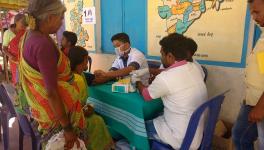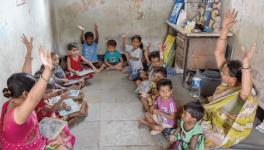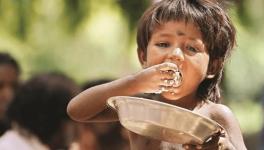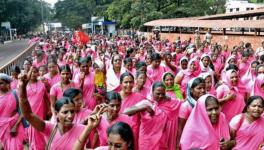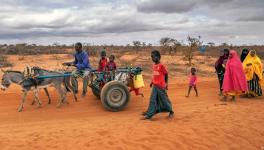Can Child Stunting be Reversed in UP and Bihar?
Image for representational use only.Image Courtesy : The Hindu
Driving through the agricultural belt of Eastern Uttar Pradesh and Bihar, one point that hit home hard is just how underweight and malnourished the majority of children living in these villagers are.
In village after village, young kids who should be in school, were found working along with their relatives helping in weeding operations or cutting cattle feed. Children living in dalit-dominated villages seemed more poverty stricken than in villages with a larger percentage of upper caste residents.
Tedha village in Mirzapur district is a dalit-dominated village with mud hovels and dilapidated front doors. The majority of villagers belong to the Budar caste with the menfolk working as daily labourers in the nearby towns of Mirzapur and Bhadohi where they often end up being paid as little as Rs 100 per day.
The situation is even more grim when one crosses into Bihar where poverty-stricken parents are said to be forcing children as young as seven and eight years old to start working in the fields. The grimness of the situation can be gauged from the fact that Minister of Women and Child Development, Smriti Irani, admitted before Parliament on July 26 that 48.3% of Bihar’s children under five years -- meaning half the number of kids in the state -- are stunted owing to poor nutrition. A frightening prospect, because not only does this affect the child’s physical growth but also cognitive skills.
UP, India’s most populous state, fares a little better. The National Family Health Survey (NFHS) data quoted by Irani shows that the percentage of child stunting is 46.3%, if that is any consolation.
India is witnessing a nutrition crisis, confirmed by the NFHS 4 data which provides district-wise details of this silent emergency. The Global Nutrition Report 2016 and the Global Hunger Index 2017 reiterate the same findings as does the most recent Global Burden of Disease Study written, amongst others, by scientists at the Indian Council of Medical Research.
The moot point is what is the situation on the ground? Sunita Singh of Sahayog, who works at the grassroot level in UP and Bihar, believes, “We need to look at the larger picture in order to understand the dimensions of the nutritional crisis. Last year, in September, eight villagers from the Musahar community died due to starvation in the Kushinagar district of UP. I visited their homes and although they had MNREGA (central rural job guarantee scheme) job cards, they were given no work. There is no health centre in a 30-kilometre radius in this area and there are no ASHA (Accredited Social Health Activist) workers either. Ever since the public distribution system (PDS) has been linked to the Aadhar card, the very poor are not able to access rations,”
This year again, there have been reports of more hunger deaths in this district, Singh said, adding that “the most disturbing news one heard is that the state government is planning to start a pilot project in the two UP districts of Lucknow and Barabanki where they intend to stop giving dry rations to the poor and will instead start transferring money directly into the accounts of women. The poor are going to be left high and dry.”
She wondered that when people were fighting for survival, how would they be in a position to provide nutritious meals for their children.
Dr Y K Sandhya, who works in Sahayog’s head office in Lucknow, also expressed concern over the linking of PDS with Aadhar cards. “The poor are already facing difficulty in accessing rations, giving them money is only going to make things for difficult for them,” she said.
As a medical practitioner, Sandhya said that it shocked her to see the dearth of staff at the Community Health Centres (CMS). “How can we have proper institutional deliveries without proper medical staff and blood banks? This leads to high levels of morbidity and mortality. Funding for CMS is being slashed. How can we remove malnutrition without providing food security for the marginalised? I am convinced the problem of malnutrition cannot be tackled without improving the situation of our farmers,” she added.
When asked the same question, women folk in Tedha village pleaded for the creation of better employment facilities. They said they had earlier approached the Union Minister of State for Health, Anupriya Patel, to build a CMS for them in their village but this did not materialise.
Have they benefited from Prime Minister Narendra Modi’s welfare schemes? In answer to this question, many villagers said that toilets had been constructed under the Swachh Bharat Abhiyan but 80% of these remain unused because families have run out of money could not complete construction. Others admitted to receiving a gas cylinder and stove under the Ujjwala scheme but said they were in no position to refill those.
Tedha has a primary school with five teachers, who receives a total salary of Rs 45,000 per month. But since there is little accountability, they seldom show up in the schools.
It is this lack of accountability of government functionaries and not just lack of funding that is responsible for this nutritional crisis, say experts.
Dr Jashodhara Dasgupta, who heads the National Foundation of India, said: “There is abysmal governance in both these states for the mid-day meals and the overall ICDS (Integrated Child Development Scheme) with food contractors and suppliers openly taking cuts. The result is that functionaries are not delivering,” she said.
State government support makes all the difference in tackling malnutrition, as seen in Odisha and Chhattisgarh, which are tackling malnutrition at the community level with village women in the forefront. “They are also being encouraged to grow a kitchen garden, which makes a great deal of difference,” said Dasgupta.
According to NFHS 4, only 5% of children aged between 6 and 23 months in rural UP gets an adequate diet. In fact, 18% of children under the age of 5 are wasted; 41% are underweight. Even amongst adults, the lack of adequate nutrition is apparent: 28.1% of women and 29.1% of men have below normal body mass index.
The state and Central governments have made several interventions to address the problem of poor nutrition, including the State Nutrition Mission, ICDS and the National Nutrition Mission with an approved three-year budget of Rs 9,000 crore. Yet nothing seems to be adding up.
What is the view of medical practitioners closely associated with these schemes. Dr Dasgupta lists out a series of musts, including breast feeding and complementary feeding, treatment of acute malnutrition, micronutrient supplementation, deworming and diarrhoea control and proper nutrition of pregnant and lactating women, as necessary interventions to end child stunting.
Dr Sridhar Kantiah of CARE, who is stationed in Bihar, insists the two thrust areas have to be to ensure that the food basked in people’s homes becomes more diverse and their sanitation conditions are improved.
Along with this, there is a demand to increase budgetary outlays for Centrally- sponsored schemes to ensure better nutrition at the ground level. Unfortunately, even the existing allocated funds are not being fully utilised.
The writer is an independent journalist based in Delhi.
Get the latest reports & analysis with people's perspective on Protests, movements & deep analytical videos, discussions of the current affairs in your Telegram app. Subscribe to NewsClick's Telegram channel & get Real-Time updates on stories, as they get published on our website.









